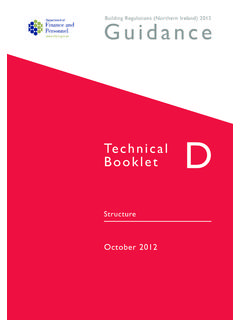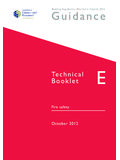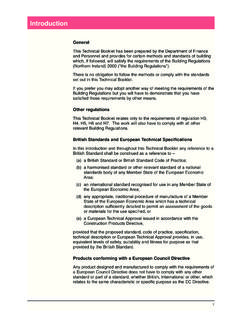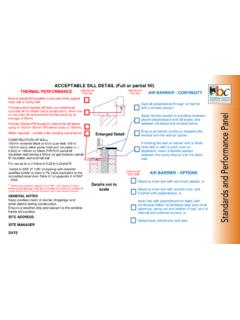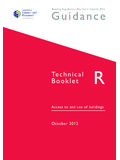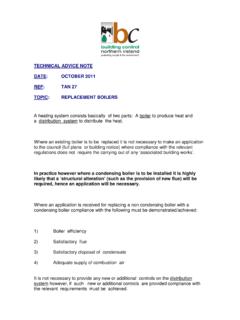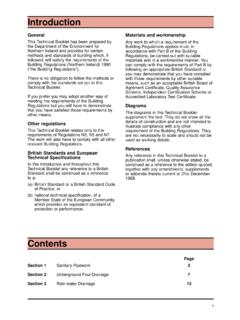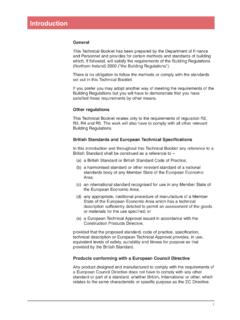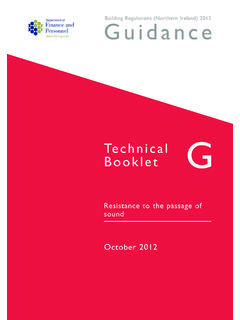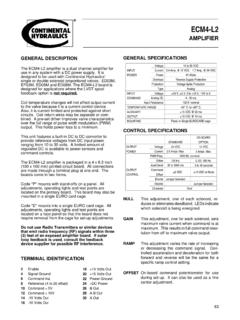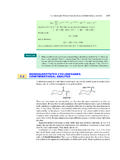Transcription of ech Booklet FI MASTER - Building Control NI
1 Guidance Department of Building Regulations (Northern Ireland) 2012. Finance and Personnel Te c h n i c a l Booklet K. Ventilation October 2012. Contents page Introduction 3. Part K Regulations 6. Guidance - Performance and introduction to provisions 8. Section 1 General 10. Definitions 10. Section 2 Ventilation of dwellings 19. NEW DWELLINGS 19. Method 1 Ventilation rates 19. Method 2(i) Ventilation systems for dwellings without basements 21. System 1 Background ventilators and intermittent extract fans 23. System 2 Passive stack ventilation (PSV) 28. System 3 Continuous mechanical extract (MEV) 31. System 4 Continuous mechanical supply and extract with heat recovery (MVHR) 34. Method 2(ii) Ventilation systems for dwellings with basements 38. Method 3 Other ventilation systems 39. EXISTING DWELLINGS 41. Section 3 Ventilation of new buildings other than dwellings 43.
2 OFFICES 44. Method 1 Ventilation rates 44. Method 2 System guidance 46. Method 3 Alternative approaches 47. Method 4 Other ventilation systems 47. OTHER Building TYPES 48. Section 4 Ventilation of replacement windows 52. Section 5 Ventilation of car parks 53. Technical Booklet K: 2012 Ventilation 1. Appendix A Performance-based ventilation 54. Appendix B Rapid ventilation 62. Appendix C Example calculations for ventilation sizing for dwellings 64. Appendix D Minimising ingress of external pollution into buildings in urban areas 73. Appendix E Publications referred to 76. 2 Ventilation Technical Booklet K: 2012. Introduction Technical Booklets This Technical Booklet , which takes effect on 31st October 2012, is one of a series that has been prepared by the Department of Finance and Personnel (the Department) for the purpose of providing practical guidance with respect to the technical requirements of the Building Regulations (Northern Ireland) 2012 (the Building Regulations).
3 At the back of each Technical Booklet is a list of all the Technical Booklets that have been prepared and published by the Department for this purpose. The guidance given in a Technical Booklet includes performance standards and design provisions relating to compliance with specific aspects of the Building Regulations for the more common Building situations. If the guidance in a Technical Booklet is followed there will be a presumption of compliance with the requirements of those Building Regulations covered by that guidance. However, this presumption can be overturned, so simply following the guidance does not guarantee compliance. For example, if a particular circumstance is not one of the more common Building situations the design provisions given in the Technical Booklet may not be appropriate. There are likely to be alternative ways of demonstrating compliance with the relevant requirements of the Building Regulations other than by following a design provision given in a Technical Booklet .
4 There is therefore no obligation to adopt any particular provision set out in a Technical Booklet , should you decide to comply in some other way. However, you will have to demonstrate that your alternative solution meets the relevant requirements of the Building Regulations by those other means. This Technical Booklet Requirements The guidance contained in this Technical Booklet relates only to the requirements of regulations 65, 66 and 68. The work will also have to comply with all other relevant requirements of the Building Regulations. Materials and workmanship Any Building work which is subject to requirements imposed by Part A of the Building Regulations should be carried out in accordance with regulation 23. of those regulations. Guidance on meeting these requirements for materials and workmanship is given in Technical Booklet B which supports Part B.
5 The Building Regulations are made for specific purposes, primarily securing the health, safety, welfare and convenience of people and for the conservation of fuel and power. Standards and technical approvals are relevant guidance to the extent that they relate to these purposes. However, they may also address other aspects of performance such as serviceability, or aspects which although they relate to health and safety are not covered by the Building Regulations. Technical Booklet K: 2012 Ventilation 3. Named standards Where this Technical Booklet makes reference to a named standard, the relevant version of the standard is the one listed in Appendix E. However, if this version has been replaced or updated by the issuing standards body, the new version may be used as a source of guidance provided that it continues to address the relevant requirements of the Building Regulations.
6 Diagrams The diagrams in this Technical Booklet supplement the text. They do not show all the details of construction and are not intended to illustrate compliance with any other requirement of the Building Regulations. They are not necessarily to scale and should not be used as working details. Protected buildings District councils have a duty to take account of the desirability to preserve the character of protected buildings when carrying out their functions under Building Regulations. Therefore, where work is to be carried out to a protected Building to comply with Part K or any other Part of the Building Regulations, special consideration may be given to the extent of such work for compliance where it would unacceptably alter the character or appearance of the Building . Protected buildings are defined in Article 3A(2).
7 Of the Building Regulations (Northern Ireland) Order 1979 (as amended). Other legislation The provisions of this Technical Booklet relate to the requirements of Building Regulations and do not include measures which may be necessary to meet the requirements of other legislation. Such other legislation may operate during the design or construction stages or when a Building is brought into use and can extend to cover aspects which are outside the scope of the Building Regulations. The Workplace (Health, Safety and Welfare) Regulations (Northern Ireland) 1993. The Workplace (Health, Safety and Welfare) Regulations (Northern Ireland). 1993 (the Workplace Regulations) contain some requirements which affect Building design. The main requirements are now covered by the Building Regulations, but for further information see The Workplace Regulations and the Workplace Health, Safety and Welfare Approved Code of Practice.
8 The Workplace Regulations apply to the common parts of flats and similar buildings if people such as cleaners, wardens and caretakers are employed to work in these common parts. Where the requirements of the Building Regulations that are covered by Part K do not apply to dwellings, the provisions may still be required in the situations described above in order to satisfy the Workplace Regulations. 4 Ventilation Technical Booklet K: 2012. The Air Quality Standards Regulations (Northern Ireland) 2010. The Air Quality Standards Regulations (Northern Ireland) 2010 transpose EU Directive 2008/50/EC on ambient air quality and cleaner air for Europe and include certain provisions of Directive 2004/107/EC relating to arsenic, cadmium, mercury, nickel and polycyclic aromatic hydrocarbons in ambient air, and Council Decision 97/101/EC on the exchange of information.
9 The objective of this legislation is to ensure government takes appropriate steps to improve air quality by reducing the impact of air pollution on human health and ecosystems by setting standards for key pollutants, and provide air quality plans which demonstrate how air quality standards will be achieved and maintained. The government will make available to the public up to date information on a daily basis of recorded levels of pollutants and annual reports of results. Technical Booklet K: 2012 Ventilation 5. Part K Regulations Part K (comprising regulations 64 68) of the Building Regulations which sets out the requirements for the provision of ventilation of buildings, has been replicated below for the convenience of the user of this Technical Booklet and is taken directly from the Building Regulations (Northern Ireland) 2012.
10 Any person who intends to demonstrate compliance with the Building Regulations by following the guidance given in this Technical Booklet is advised to ensure that the regulations below are current on the date when plans are deposited or notices given to the district council. As Part A (comprising regulations 1 21) of the Building Regulations sets out the interpretation along with the procedural requirements relating to the application of the regulations, the Department advises that all Parts of the Building Regulations be read in conjunction with Part A of those regulations. The Building Regulations (Northern Ireland) 2012 and any subsequent amendment may be viewed by following the links from the Department's website at . PART K. Ventilation Application 64. (1) Regulation 65 shall not apply to a Building or a space within a Building which is used solely for storage or which is otherwise not intended for use by people.
